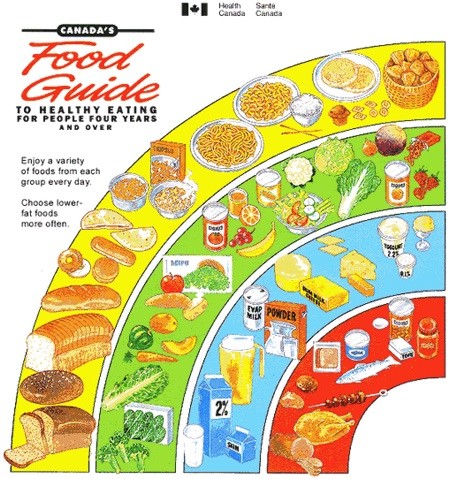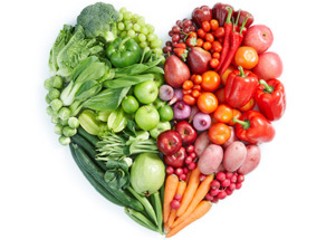My friend, Cathy, emailed me the other day asking, “What is your idea of a healthy diet and what are the essentials we should have?” That’s a deceptively simple question – with a potentially very complex answer!
 Canada’s Food Guide: A great place to discover what Variety and Balance
Canada’s Food Guide: A great place to discover what Variety and Balance
are all about! Download your copy here.
Says Cathy: “I always thought that an essential diet was merely a balance of meat and potatoes. That oversimplification was merely a counterbalance of an old woman who lived on just daily multivitamins and tea.”
Not too far off the mark
Okay… Sounds familiar! I recall reading, in a foodservice publication not too long ago, about an older, retired widower gent living on his own who proudly claimed he got a complete, balanced diet by having a bowl of ‘chunky style’ soup for lunch every day with two slices of buttered white toast.
“It’s got everything in there you want me to eat every day!” the old fellow protested to his doctor. “Meat, vegetables, potatoes; the lot!”
His overall plan was to satisfy his doctor at lunch and indulge his own cravings at supper, reasoning that he could eat anything he liked the rest of the day, once he’d had his prescribed meat, veggies and starch.
As you may have guessed, it doesn’t work that way. Our crafty senior was, in fact, taking in way too much salt and fat. Not to mention a lot of empty sugar and alcohol calories! His blood pressure and cholesterol readings were a mess.
So, what’s ‘essential’?
Nutritionists tell us our bodies need a certain amount of protein, sugar, vitamins and minerals to stay healthy. But we also need dietary fibre and mechanical fibre (bulk), an array of fatty acids, and minerals to make the old bus run smoothly. That’s one of the problems with ‘convenience’ foods and other processed food products. Many are so processed that all or most of the natural goodness – notably vitamins and minerals – have been processed out of them. That’s why, if I was offered a choice of ‘Whole Grain’ cereal, ‘Frosted Flakes’ or old fashioned oatmeal for breakfast, I’d take the oatmeal every time.
In a word, ‘essential’ can be restated as ‘variety’.
Man cannot live on bread alone, saith the old adage. Too true. But you can’t live on just meat and potatoes, either. For a healthy, balanced diet, you have to add green and orange/red vegetables and fruits, a variety of grain products (including whole grain breads) and other goodies, such as seeds and nuts.
Bravo for balance!
But it’s also important to get the right amounts of all these delicious things. The problem with today’s diet, particularly that of urban go-getters – which is all too often reliant on convenience foods, fast foods and restaurant meals – is that it provides diners with too much fat, salt and sugar and not enough vitamins, minerals and fibre.
Balance and variety go hand-in-hand. You can’t stay healthy by eating the same things every day, even if you have a serving each of everything the nutritionists say you should. There’s more to green veggies than string beans and canned peas. And there’s more to protein than hamburger patties. Not to mention all the different ways you can have foods prepared.
Problems at both ends
No, we are not drifting into a discussion of dietary ‘regularity’. We’re going from our senior friend, who ate soup everyday for lunch and thought he had nutrition down pat, to the other end of the age continuum: teens.
I keep hearing stories about teenagers who (rightly or wrongly) pass up school cafeteria fare in favour of fast food for lunch. Every day. And that can also include weekends, when they’re out ‘hanging’ with their buds.This kind of monovorism can be just as bad or worse than the soup guy’s habit.
Like the soup guy, these kids are getting way more fat, salt and sugar than they need, even if they’re physically active, in organized sports or casually, as in skateboarding. Those token pieces of lettuce and tomato, and the three pickle chips on your double burger do not a dietary balance make.
So where does that leave us?
Cathy: Just eat a lot of different things! Make sure you get all the colours in there (see above). And don’t go overboard on any one food. Or type of food. For instance, you need protein. But it shouldn’t always be the same thing. I mean, there’s only so many ways to cook a chicken breast! And there’s a recent recommendation from health professionals to eat more fish and seafood, particularly.
Here’s another good tip: Listen to your body. Give in to your cravings, from time to time – especially if they’re strong. It could be your body telling you you’re short on some important nutrient!
You’re going to find that eating healthy is easier than you thought, and a lot more fun!
Bon appétit!
~ Maggie J.


Dear Maggie J.
I had no idea that eating was so complicated. You made a great entry for the topic of diet. Yes, there are ups and downs in life just as there are in daily ‘input’. Some old remedies still have a lot of goodness wrapped up in them whether by chance or by intention.
There is the story of Lazarus Long, who was cured of a serious wound with the miraculous mix of egg, honey, and apple cider vinegar. The three natural ingredients have a wide range of unique minerals and vitamines. Only in the movies do such cures actually work, although there is a hint of truth behind them.
I always treat a cold or flu with lemon slices in hot water sweetened with three tablespoonfuls of honey. The vitamin C in lemon and the astringent of honey will feed your body with a combination of nutritional energy. The same goes for chicken soup to revitalize and rehydrate a sick body. Some people refer to onion soup as a cure for colds. So, it all depends upon what foods are in your cultural background.
I don’t know if libraries list the mineral and vitamin content of common ingredients. I suppose that taste has much to do with the preference for food. It’s said that man does not live by bread alone, meaning that there are far more things to eat.
Take care for now,
Cathy
Cathy: Good catch! Health Canada offers this free, detailed listing of nutrients found in a wide variety of foods commonly consumed in Canada: http://www.hc-sc.gc.ca/fn-an/alt_formats/pdf/nutrition/fiche-nutri-data/nvscf-vnqau-eng.pdf